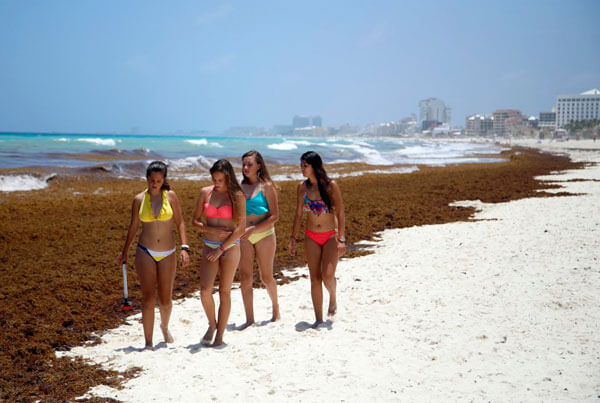In normal circumstances, Caribbean tourism officials usually worry about problems like high air fares, deals offered by cruise liners, tax incentives for the sector and the general state of the global economy to ensure tourist patronize their destinations not about muck on beaches.
But a new enemy is now lurking on the turquoise waters of the region, taking over its beaches or occupying white sandy areas that are usually occupied by tourists from Europe and North America.
From Guyana on the South American mainland to as far north as Antigua in the Eastern Caribbean and Mexico in North America, huge masses of sargassum seaweed have been washing up on beaches in the region, turning away tourists, forcing hotel cancellations in the current pricey summer peak season, trapping vessels and even affecting the ability of turtles to nest and produce offspring.
So bad is the situation in Tobago, the tourism sister island of Trinidad, that its House of Assembly this week called for an emergency meeting of Caribbean leaders to discuss the issue as various countries have been inundated with this phenomenon at least since 2011 but up to late this week there had been no indication that high officials would meet.
Orville London, the head of the Assembly is worried that the island economy will be so badly affected by seaweed deposits as high at six feet on beaches that it has set aside $500,000 in emergency funding to deal with the issue.
Officials say they are frankly overwhelmed and simply need to defer to higher officials like regional leaders for answers.
Photographs published by media houses in Trinidad paint an unbelievable picture of a reddish-brown mass of ‘dye’ completely occupying beaches, stretching out to areas of the sea where tourists would normally take a dip in the Atlantic.
While nearly every country is affected by the invasion that is believed to come from Africa and Europe, Tobago has simply been swamped by this unprecedented problem that could ruin its economic stocks in the last half of 2015.
People like London say they are looking to the Barbados-based Caribbean Tourism Organization (CTO) to push leaders into meeting to decide what to do as locals have no answer for this assault of nature.
Guest houses on Tobago’s east and west coast that are usually filled with sun-seeking arrivals from the north at this time of year are instead dealing with cancellations
Supporting London as he spoke to reporters was Linford Beckles, the Director of the Environmental Department.
“The situation at Speyside is such that the longer the material stays on the beaches it gets even more smelly, and the waters will get even more septic. So from the point of view of logistics and efficiency, we will have to identify the disposal locations that are relatively close to the affected areas,” he said.
But while Tobago is latest and perhaps the worst affected, officials in Barbados and Antigua, for example, have been forced to battle this issue much of the past four to five years.
Recenty in Barbados, environmentalists counted 42 dead turtles, trapped in the stifling embrace of seaweed which ironically sustains other life forms like worms, jacks and tunas.
Still, a few entrepreneurs in Barbados, for example, are drying out the weeds, removing its salt and repacking them as natural, organic fertilizers that some supermarket chains are carrying





















